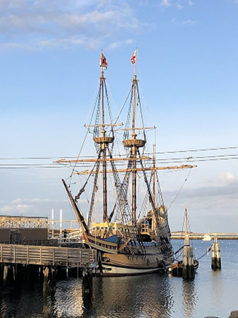Author’s Note: Research is credited to National Day Calendar, Plymouth Patuxet Museums and Britannica
We are still a ways out from the holiday season, but as it is there are plenty of Halloween decorations up before Labor Day and Christmas started its own festivities with Christmas in July (Hobby Lobby seems to pull their Yuletide merch out as soon as the fireworks stop on the Fourth of July).
With this being the case, I feel no guilt about throwing in a Thanksgiving-themed article right in the middle of September, especially when it’s historically appropriate.
On Sept. 16, 1620, the Pilgrims set sail from Plymouth, England to the New World on the ship, The Mayflower. Sept. 16 is now National Mayflower Day.
102 men, women and children from all walks of life–many seeking religious freedom, some seeking fame and fortune–left the comfort of their homes in Europe to live in a world they knew very little about. Out of these 102 passengers, only one died during the voyage.
Out of the 101 left, just fifty survived that first winter in Plymouth. Only five were children.
The Mayflower, however insignificant it may have seemed in 1620, had a huge impact on history as we know it today
The passengers and crew spent sixty-six days at sea, blown off course by storms, and eventually settled in Cape Cod, over six hundred miles north of their original destination in Virginia. These Pilgrims came to establish the tradition of Thanksgiving in North America.
As for the Mayflower, the ship’s fate following its return to England in April of 1621 is mostly unknown. Legend claims it was scrapped and used to build a barn in Buckinghamshire in England, but there is no documented evidence of its whereabouts after 1624.
The Mayflower, however insignificant it may have seemed in 1620, had a huge impact on history as we know it today. It was supposed to be one of two ships crossing the Atlantic, but the other vessel, the Speedwell, was forced to stay behind due to not being seaworthy enough to make the long voyage.
With that being the case, the Mayflower doubled its passengers and cargo and weathered terrible storms to bring the Pilgrims safely to the New World.
Today, you can see a replica of the Mayflower at the Plymouth Patuxet Museum in Plymouth, Massachusetts, where the original Pilgrims settled over four hundred years ago. Despite being a seemingly small piece in the grand scheme of the world throughout the centuries, it has earned its own national holiday for the American people.
